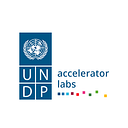Exploring satellite data for sustainable development
Bertrand Frot, Chief Portfolio Manager
At UNDP, we are using satellite data to support decision-making around development challenges in over 60 countries. So far, we’ve seen the value of satellite data for understanding migration patterns, monitoring reconstruction in difficult-to-access areas, and evaluating the impacts of climate change on agriculture.
Understanding migration
UNDP’s recent report “Scaling Fences,” tells the stories of migrants who embarked on this journey not to seek asylum or because of persecution, but because their pursuit for a better life seems out of reach in their home countries.
Scaling Fences highlights that migration is a reverberation of development, and despite progress, it is not fast enough to meet people’s aspirations.
A key question in the migration debate is how can investments be made back home to support development there? Satellite technology can be used to learn about the source cities of migration by revealing patterns or spatial relationships. For instance, we can explore how public services are distributed throughout a given city and then measure how accessible these services are to neighborhoods of varying socioeconomic status. In Cairo, we examined where the schools, hospitals, and other key public services were located in relation to slums and this helped us work with partners to target limited resources to those who need it most.
As migration patterns continue to be influenced by multiple factors — climate change, violent conflicts, or the pursuit of better livelihoods, satellite technology will be a vital resource to deepen our understanding about the causes and potential solutions to this increasingly complex global challenge.
Monitoring wetlands and crop yields
We have also found that combining satellite data with other layers of information enables us to dive deeper and act faster into the challenges of climate change. At UNDP, we have focused many projects on evaluating climate change impacts, and we rely on satellite data to better inform this work and guide our climate action. For example in Uganda, with the help of satellite data, we are monitoring the impacts of human activities and climate change on the evolution of wetlands. In Indonesia, we are using satellite imagery to explore how floods are impacting local rice culture, such as farmers’ techniques and crop yield.
The recent launch of the Space Climate Observatory (at the One Planet Summit by CNES with 22 other space agencies and UNDP) provides open source data and allows for a large international scientific study of the impacts of climate change on a global scale.
Reconstruction monitored from space
Satellites can also be used to improve the monitoring of reconstruction efforts in difficult to reach areas. In Mali and Nigeria, for example, satellite imagery was used as a tool to monitor our rebuilding efforts. The data allowed us to zoom in and capture important building features — from space! A key concern was to ensure that we could monitor reconstruction projects in the northeastern area of Mali after a series of terrorist attacks. Given that the area was dangerous to reach; the stakes were high. While a few teams were in place on the ground, we wanted to avoid sending additional people to the region. Satellite images offered a clear, safe solution.
During a crisis, such as a natural disaster, we activate “Copernicus” (funded by the European Union) or the “International Space Charter” to receive maps of damage assessments at no cost, in near real time. This is now part of the standard procedure used by the UNDP Crisis Bureau.
Getting smarter together…with satellites
Part of our work at the Accelerator Labs is to tap into collective intelligence, or simply: to get smarter together. Satellite data is a part of this equation! Thanks to satellites, we are monitoring reconstruction in post-conflict or post-disaster zones at reduced cost and risk. Satellite data also enables us to see the effects of climate change and to better observe and identify workable climate action solutions. We’re hoping this data will boost our understanding of where and what things are working.
